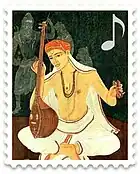 | ||||||
| Music of India | ||||||
| Genres | ||||||
|---|---|---|---|---|---|---|
|
Traditional
Modern |
||||||
| Media and performance | ||||||
|
||||||
| Nationalistic and patriotic songs | ||||||
|
||||||
| Regional music | ||||||
|
||||||
Nacni means female dancer in north Indian languages. In the east-central Indian states of Jharkhand, West Bengal, and Orissa, the term nacnī (lit. "dancer" pronounced NUCH-nee) refers to female performers who sing and dance professionally in rural areas, accompanied by male ḍhulkī and nagarā drummers who move around the stage with her.[1][2]
Women who perform as nacnīs are considered "kept women" and are usually paired in an informal "marriage" with a male manager and dancing partner, typically of a higher caste.[3][4] In this pairing, nacnīs are thought to embody the goddess Radha while the male dancing partner is a stand-in for Krishna. The performers are considered out-caste and in many ways transgress usual Indian caste and gender distinctions both on and off stage, taking on a certain power role among their "fans" and often engaging in "typically male" behavior, such as drinking and smoking.[5][6] This style of performance is rapidly disappearing.[7]
References
- ↑ Babiracki, Carol M. (2008), "Between Life History and Performance: Sundari Devi and the Art of Allusion", Ethnomusicology, 52 (1): 1–5
- ↑ Citron, Marcia J. (2005), "Women's Voices across Musical Worlds (review)", Music and Letters, 86: 508–512, doi:10.1093/ml/gci090
- ↑ Feldman & Gordon (2006). The courtesan's arts: cross-cultural perspectives. New York: Oxford University Press. p. 118. ISBN 9780195170290.
- ↑ Babiracki, Carol M. (2008), "Between Life History and Performance: Sundari Devi and the Art of Allusion", Ethnomusicology, 52 (1): 3–6
- ↑ Soren, Ragnhild (1999), Gendered Images of Music and Musicians (PDF)
- ↑ Babiracki, Carol M. (2008), "Between Life History and Performance: Sundari Devi and the Art of Allusion", Ethnomusicology, 52 (1): 5–6
- ↑ Feliciano, Rita (2006), "Kathak at the Crossroads: Innovation Within Tradition", Dance View Times, 4 (35)
Further reading
- Chakravarti, Nisith (2001). Nachni: The Dancing Girls of Rural Bengal. Saptarshi Prakashan.
- Sengupta, Saloka; Narasimhan, Haripriya (June 2020). "Ki sambandha hoibe takhon he? : Locating Nachnis in the Societal Margins of Kinship in Rural Bengal". Indian Journal of Gender Studies. 27 (2): 282–301. doi:10.1177/0971521520910970. ISSN 0971-5215.</ref>